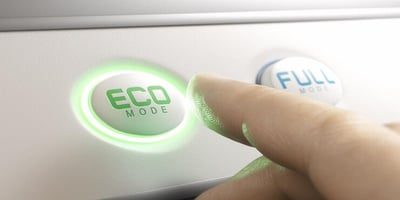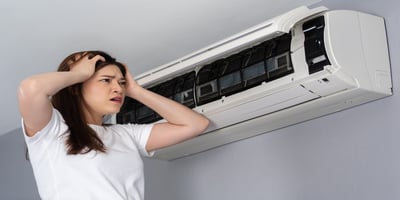What Makes an Air Conditioner Environmentally Friendly? 5 Key Factors
Most of us rarely stop to think about the environmental cost of staying cool. But as summers get hotter and energy demands keep climbing, that quick blast of AC is doing more than just chilling the air — it’s impacting the planet. The good news? Today's eco-friendly air conditioners are designed to proactively address energy consumption and environmental impact. It's about smart, more sustainable cooling that respects our planet without compromising comfort, plus it's about cutting your electric bill. So, what makes an AC actually ecologically conscious? Let’s dig into five factors that set these green machines apart.
Energy Efficiency
It's a hot day. Or even a season. Your air conditioner is working 24/7. How much electricity do you think it consumes? Now imagine that multiplied across millions of homes. It adds up quickly, leaving a hefty carbon footprint. The good news? Contemporary environmentally conscious air conditioning systems are designed to maximize efficiency—reducing power consumption, minimizing waste, and lowering environmental impact. However, not all AC units are equal. How to choose the right model? It is about efficiency.
If you’ve come across labels featuring terms such as SEER (Seasonal Energy Efficiency Ratio) or EER (Energy Efficiency Ratio), here’s what they actually represent:
- SEER indicates the efficiency of an air conditioner throughout a complete cooling season, taking into account actual conditions such as varying temperatures.
- EER, conversely, assesses performance at a constant temperature. The greater these ratings, the more efficiently your AC will manage the heat without straining itself — or your electricity costs.
When shopping for an air conditioner that minimizes energy consumption, it's important to consider more than just the statistics. Smart cooling technology, which adapts settings according to your habits, along with ENERGY STAR certification, serves as dependable signs of an efficient system. These features allow you to reduce power consumption while maintaining the same level of comfort.
Over time, choosing a more efficient air conditioner isn’t just a financial decision. It’s a shift toward cooling that works with the environment, not against it. And the longer you use it, the more those small savings compounds — for your wallet and for the planet.
.jpg?width=800&height=400&name=1282%20(1).jpg)
Eco-Friendly Refrigerants
Though most people do not consider it, the refrigerant inside an air conditioner is particularly important for the operation of a cooling system and for causing environmental damage. Older air conditioners ran on conventional refrigerants like R-22, which contributed to ozone depletion and global warming. Although these compounds had a significant environmental cost, they were quite effective at chilling.
Luckily, the business is turning toward greener substitutes. Modern refrigerants such as R-32 and R-290 are meant to greatly reduce environmental risks while still providing strong cooling capacity. These environmentally friendly refrigerants have zero ozone depletion potential and a smaller global warming potential than more traditional choices. Put simply, they chill your house without increasing global temperature.
But why does this matter when selecting an efficient air conditioner? Simply said, the kind of refrigerant affects more than emissions. Air conditioners using sustainable refrigerants typically run more effectively and require less energy to produce the same cooling effects. This means reduced strain on the planet's resources and lower electricity costs over time.
Choosing an air conditioner with one of these next-generation refrigerants will help anyone wishing to lessen their environmental impact. This small decision results in better air, less pollution, and a time when cooling technology won't be at the cost of the earth.
Smart Technology Integration
Imagine never worrying if you left the AC running after you hurried out the door. Or coming home to a perfectly cooled room, without lifting a finger. The magic of a smart air conditioner is that it not only cools your room but also thinks for itself, enabling you to reduce energy waste and lower your bills without even trying.
The environmentally friendly air conditioners of today have much more functionality than just "on" and "off.". While remote control apps make it simple to change the temperature from your phone — whether you're at home or not—programmable thermostats let you create cooling schedules that fit your daily routine. Actually, smart sensors are the real game-changer. These sensors can identify when a room is empty or when the temperature changes, so adjusting the performance of the AC in real-time to prevent waste of energy on cooling areas not requiring it.
And it doesn’t stop there. When integrated with smart home systems like Google Home or Amazon Alexa, your AC becomes part of a connected ecosystem. Want to cool the living room before movie night? Just ask. Are you curious about how much energy you’ve used this week? Your AC can provide insights, helping you track and optimize your energy consumption over time.
What makes these smart features even more valuable is the balance they strike between convenience and sustainability. You get better control over your comfort, while your AC quietly works in the background to reduce unnecessary energy use. It’s a simple shift toward smarter cooling — and a more sustainable way to stay comfortable all year round.
.jpg?width=800&height=400&name=139%20(1).jpg)
Sustainable Manufacturing and Materials
Ever thought about what happens before an air conditioner even reaches your home? It doesn’t just pop out of thin air. Factories hum with machinery. Materials are mined, molded, and assembled. And each step leaves a footprint.
Here’s the problem — for years, that process wasn’t exactly clean. Factories churned out emissions. Plastics were used once and tossed. Waste piled up. But that’s changing. Slowly, yes, but it’s happening.
Some brands are waking up to the reality: if you’re making eco-friendly air conditioners, the production process should be part of the solution — not part of the problem.
So, what does that look like in real terms? It means smarter choices at every step:
- Materials that can be recycled. Instead of plastics that sit in landfills for centuries, manufacturers are opting for metals and components that can be broken down and reused.
- Factories that waste less. Some brands have embraced closed-loop systems, recycling leftover scraps from production instead of throwing them away.
- Energy-efficient assembly lines. Think solar-powered factories or manufacturing processes that use less electricity overall.
It’s not just about the AC unit you bring home. It’s about how it got there. And if companies put sustainability at the core of their operations, it reduces the environmental impact long before you hit the power button.
Sure, it might not be the first thing you think about when buying an air conditioner. But it matters. Because cooling your space shouldn’t mean heating up the planet.
Proper Maintenance and Longevity
Buying an environmentally friendly air conditioner is a great start, but it’s not the whole story. The real secret to keeping your AC efficient — and eco-friendly — lies in how well you take care of it. Like any appliance, an air conditioner needs regular attention to perform its best. Neglect it, and you’ll see energy bills climb, performance drop, and its lifespan cut short. But with a little effort, you can flip the script.
First things first: clean those filters. It might sound basic, but dirty filters force your AC to work harder, which drives up energy consumption. When airflow is restricted, your unit burns more electricity just to push cool air through. Clean filters? They keep things running smoothly, reducing energy use and keeping your indoor air fresh.
Next up: refrigerant levels. Ever had your car’s AC blow warm air because it was low on coolant? The same can happen with your home’s AC. If refrigerant levels aren’t where they should be, your unit struggles to cool efficiently. And that extra strain means more power consumption — and a bigger environmental footprint.
Then there’s the bigger stuff. Professional servicing isn’t just for emergencies. Regular checkups catch problems before they spiral into expensive repairs or early replacements. A well-maintained unit can last a decade or more, while a neglected one might need replacing in half that time. And every time an old AC gets tossed, it adds to landfill waste and requires new resources to make a replacement.
Want a system that lasts? Here’s the checklist:
- Clean filters every few months.
- Check refrigerant levels annually.
- Schedule a professional tune-up once a year.
In the long run, maintenance isn’t just about saving money (though it definitely helps). It’s about reducing energy consumption, extending the life of your AC, and keeping your cooling habits aligned with sustainability. Because the greenest air conditioner isn’t just the one you buy — it’s the one you care for.


































.jpg)



